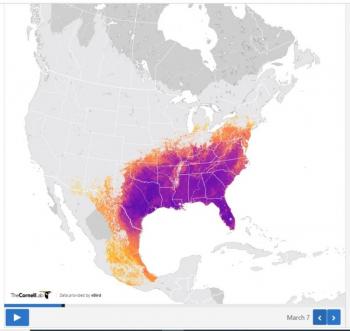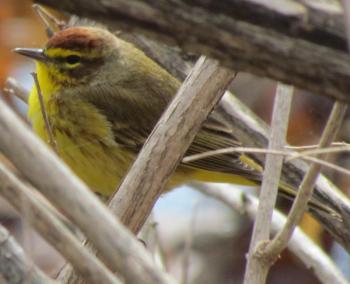Celebrating the Spring Return of Birds
The first pulses of the flow of bird migration have already began coursing across the hemisphere. Purple martins left their Amazonian wintering grounds in January to begin arriving along the Gulf Coast in early February. The vanguards of turkey vultures and red-winged blackbirds made it here to Maine over the last few weeks – we saw (and heard) our first red-wings in Dresden on Sunday. Eastern phoebes, pine warblers, ruby-crowned kinglets, palm warblers, and even Louisiana waterthrushes, black-and-white warblers, and yellow warblers are already pushing northward across the continent. Some, like the phoebes and pine warblers, may show up here in Maine within a few weeks; others perhaps not until the first days of April. Still other species may not leave their South American wintering grounds for another month until the flowing current of northward bird migrants becomes a sea in late April and May, flooding the continent with returning birds and filling the air with their exuberant songs.
We all anticipate and at least personally celebrate the return of migrant birds each spring. Their return is a fundamental reiteration of the great cycles of nature and earth. The days will get longer. Warmth will come again. Snow storms will be replaced by rain. The grass will turn green. The trees will become clothed in leaves.
All of these things are part of the natural cycle. but birds make massively long journeys as part of this cycle to go to far away places for the winter. It makes us thankful every spring for their return.
Birders today celebrate the spring migration of birds through festivals and what is now called World Migratory Day. Here in Maine there are festivals in Freeport, Rangeley, Deer Isle, Acadia, and Cobscook Bay, and probably more. Across the U.S. and Canada there are hundreds.
Indigenous peoples had their own traditions to celebrate the return of birds. In many First Nations of Canada, the return of geese and ducks was especially important because their return was often what saved people from starvation (as we wrote about in last week’s column). To show gratitude for the return of the waterfowl, many Indigenous people had special feasts, prayers, and dances that took place in the spring.
As these multitudes of birds make their way toward us here in Maine, it must be their expectation that what awaits them are safe and healthy places to raise their young or where they can rest and feed before continuing farther north. It is our hope that all of us will reflect on the ways we can ensure that birds have those intact and healthy forests, grasslands, shrublands, wetlands, lakes, and rivers that they need. Here in Maine, that means supporting the initiative to put more funding into the Land For Maine’s Future program through a bond so that land trusts, municipalities, and other groups can indeed protect the land these migratory birds expect to find at the end of their journey. Across America that means pushing for bird-friendly elected officials and fighting hard to prevent the gutting of laws such as the Migratory Bird Treaty Act that protect birds.
Let our celebration of the joyous return of birds in spring galvanize us to even more actions to make sure that they always do return.
Jeffrey V. Wells, Ph.D., is a Fellow of the Cornell Lab of Ornithology and Vice President of Boreal Conservation for the National Audubon Society. Dr. Wells is one of the nation's leading bird experts and conservation biologists and author of “Birder’s Conservation Handbook”. His grandfather, the late John Chase, was a columnist for the Boothbay Register for many years. Allison Childs Wells, formerly of the Cornell Lab of Ornithology, is a senior director at the Natural Resources Council of Maine, a nonprofit membership organization working statewide to protect the nature of Maine. Both are widely published natural history writers and are the authors of the book, “Maine’s Favorite Birds” and “Birds of Aruba, Bonaire, and Curaçao: A Site and Field Guide” from Cornell Press.






























